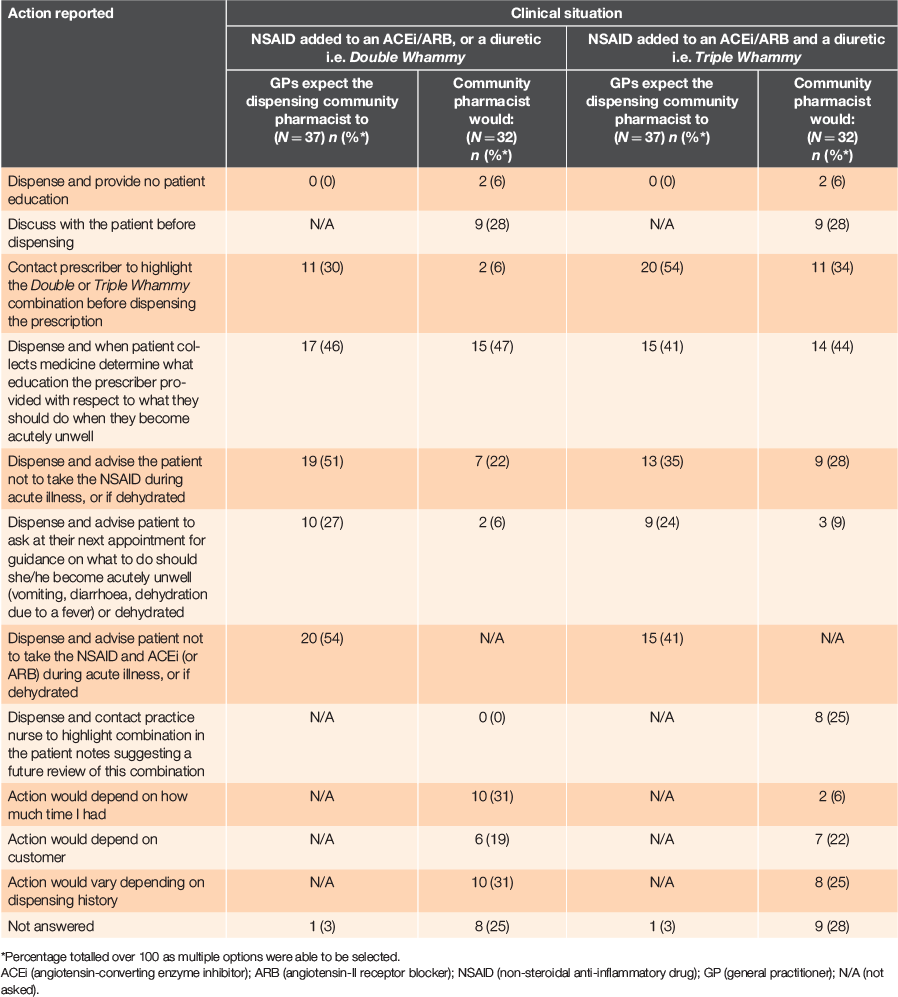Avoiding acute kidney injury in primary care: attitudes and behaviours of general practitioners and community pharmacists in Hawke’s Bay
Dianne Vicary 1 4 , Colin Hutchison 2 , Trudi Aspden 31 Vicary Pharmacy Services Limited, Napier, New Zealand
2 Hawke’s Bay District Health Board, Hastings, New Zealand
3 School of Pharmacy, University of Auckland, Auckland, New Zealand
4 Corresponding author. Email: dianne.vicary@xtra.co.nz
Journal of Primary Health Care 12(3) 244-256 https://doi.org/10.1071/HC19106
Published: 22 September 2020
Journal Compilation © Royal New Zealand College of General Practitioners 2020 This is an open access article licensed under a Creative Commons Attribution-NonCommercial-NoDerivatives 4.0 International License
Abstract
INTRODUCTION: Awareness of the effect of acute kidney injury on patient outcomes and health systems is growing internationally. New Zealand’s approach focuses on stopping consumption of ‘at-risk’ medicines when acute kidney injury has been established and raising awareness of the risks associated with the Triple Whammy drug combination.
AIM: To explore current practices and views of Hawke’s Bay general practitioners (GPs) and community pharmacists regarding patient education about medicines with potential for contributing to community-acquired acute kidney injury, with a focus on community pharmacists providing patient education regarding when to temporarily withhold ‘at-risk’ medicines during acute dehydrating illnesses.
METHODS: Two tailored cross-sectional online anonymous surveys of GPs and community pharmacists working in Hawke’s Bay were administered between 2015 and 2016. Descriptive statistics were generated from the closed-question responses and manifest content analysis was applied to the free-text responses.
RESULTS: Twenty-two percent (37/167) of GPs and 34% (32/95) of pharmacists responded. Most respondents, GPs (34/37) and pharmacists (25/32), self-reported expertise to educate patients on temporarily withholding ‘at-risk’ medicines during acute dehydrating illnesses. Twenty-nine (78%) GPs had confidence in pharmacists providing this patient education and 20 (54%) welcomed pharmacist contact regarding a Triple Whammy prescription. However, for a variety of reasons, pharmacists did not routinely provide this education or contact GPs.
DISCUSSION: Both GPs and community pharmacists reported they had expertise to provide useful patient education about ‘at-risk’ medicine use during acute dehydrating illnesses. Dialogue to clarify the role of the two groups would be beneficial to achieve a more coordinated approach to patient care. Relevant strategies and frameworks already exist, but national interprofessional leadership and local application would be beneficial.
Keywords: General Practitioners; pharmacy services; primary health care; counselling practice
| WHAT GAP THIS FILLS |
| What is already known: There is an international focus to reduce the incidence of acute kidney injury, including by providing patient education about ‘at-risk’ medicine self-management during acute dehydrating illnesses. The New Zealand Pharmacy Action Plan 2016–2020 focuses on pharmacists collaboratively working within integrated teams to support public health interventions to improve population health literacy and reduce medicine harm. |
| What this study adds: New Zealand guidance recommends clinicians stop ‘at-risk’ medicines when acute kidney injury is established and implement sick day plans for Triple Whammy combinations. GPs sometimes recommend pre-emptive temporary discontinuation of ‘at-risk’ medicines during acute dehydrating illnesses of patients in their practices, often influenced by patients’ age and renal function. Responding GPs generally support community pharmacists providing pre-emptive temporary ‘at-risk’ medicine discontinuation patient education as part of the dispensing process when either a Double or Triple Whammy combination is present. Both GPs and community pharmacists have different expectations regarding the level of patient education provided by pharmacists as part of the dispensing function and the pharmacist interventions occurring when they have professional concerns about a prescription. |
Introduction
Acute kidney injury (AKI) affects kidney structure and function and is described as an abrupt onset of renal dysfunction ranging from minor loss of function to organ failure.1,2 It is associated with increased health-care costs and is a predictor of adverse outcomes, including mortality.1–5 It has been suggested that as many as two-thirds of all AKI cases begin prior to hospitalisation, termed ‘community-acquired AKI’.1
AKI is associated with ageing, acute illness, chronic conditions, and certain medicines.1–3 International clinician guidance recommends advising patients taking an angiotensin-converting enzyme inhibitor (ACEi), angiotensin-II receptor blocker (ARB), or a non-steroidal anti-inflammatory drug (NSAID) to pre-emptively discontinue these medicines temporarily when experiencing acute dehydrating illnesses, as part of a ‘sick day plan’.3,6–8
The use of a NSAID in combination with an ACEi or ARB or a diuretic is known as a Double Whammy, or Triple Whammy if all three drug types are used; these combinations are associated with increased AKI risk.9–11 The Health Quality & Safety Commission’s Atlas of Healthcare Variation shows that >22,000 New Zealanders aged >65 years take the Triple Whammy combination annually.12 New Zealand clinicians are recommended to review the appropriateness of medicines for patients at risk of AKI and be prepared to stop treatment if AKI develops.13,14 Primary care clinician educational material encourages discussing a ‘sick day’ plan with patients taking a Triple Whammy combination and for pharmacists to discuss NSAID-associated risks with patients already taking an ACEi or ARB, with or without diuretics.15 At present, it is unknown how New Zealand general practitioners (GPs) and pharmacists have incorporated international and New Zealand guidance into their practices to minimise community-acquired AKI.
Community pharmacists professionally support prescribers and patients in the safe and quality use of medicines.16 The New Zealand Pharmacy Action Plan 2016–2020 focuses on pharmacists collaboratively working within integrated teams to support public health interventions that improve health literacy and reduce medicine harm.17 In some other countries, pharmacists have professional direction on their role in AKI-associated medicine management and have available to them specific training to support them to undertake this.6,8,18
This study aimed to explore the current practices and views of Hawke’s Bay GPs and community pharmacists regarding patient education about medicines with potential for contributing to community-acquired AKI, with a focus on community pharmacists educating people to temporarily withhold ‘at-risk’ medicines during acute dehydrating illnesses. This is phase one of a three-phase study investigating this issue.
Methods
Study group
Cross-sectional surveys of GPs and community pharmacists working in Hawke’s Bay, New Zealand, were undertaken between 2015 and 2016 using online anonymous questionnaires hosted on the SurveyMonkey platform (SurveyMonkey, San Mateo, CA, USA).
Recruitment
General practitioners: In September 2015, 167 Hawke’s Bay GPs were invited to complete an anonymous questionnaire, with reminders delivered in the Health Hawke’s Bay Primary Health Organisation (PHO) weekly email and via the PHO internal Information Portal. GPs who met with the PHO Clinical Advisory Pharmacist (Dianne Vicary) until August 2016 were sent a personal email invitation.
Pharmacists: In September 2015, an email invitation was sent by the Hawke’s Bay Chief Pharmacist to two pharmacy email distribution lists consisting of 95 individual pharmacists and community pharmacy owners. Reminders were emailed and the survey was promoted at monthly pharmacist meetings until November 2015.
Study design
Both questionnaires consisted of a mixture of Likert scale, multiple choice, and open-ended questions (see Supplementary Materials Tables S1 and S2, available at the journal’s website). Although both questionnaires explored current practices around patient education, questions relating to views on pharmacists as patient educators, management of Triple Whammy risk and demographics reflected the roles of the two groups. Three pharmacists and a GP piloted the surveys for question clarity and face validity, resulting in wording changes to remove ambiguity.
Data analysis
Descriptive statistics were generated from analysis of all closed question responses using Microsoft Excel (2007) (Microsoft Corporation, Redmond, WA, USA). Free-text responses describing perceived barriers to providing education regarding patient pre-emptive temporary ‘at-risk’ medicine discontinuation were categorised and quantified using an inductive approach and manifest content analysis.19,20
Results
Demographics of respondents
Thirty-seven GPs and 32 pharmacists completed questionnaires. Although considerable demographic data were missing, respondents tended to be older (aged 51–60 years) and GP respondents tended to be employers who completed their undergraduate studies overseas, whereas pharmacist respondents tended to be employees having completed undergraduate training in New Zealand (Table 1).
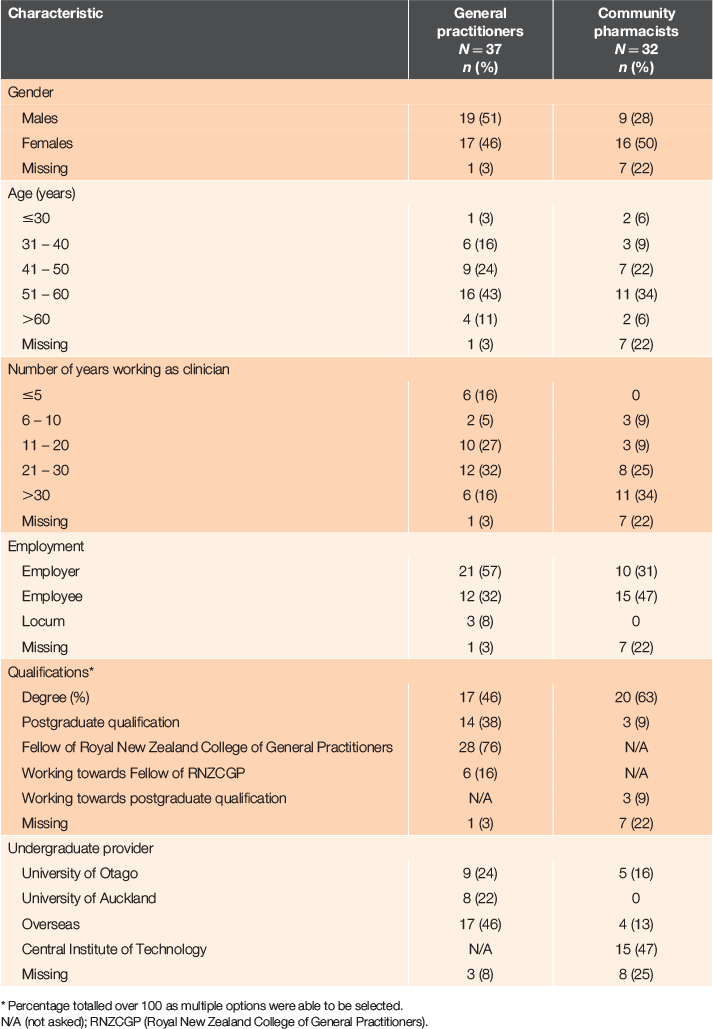
|
Current expertise and practice for educating patients to temporarily withhold ‘at-risk’ medicines during acute dehydrating illnesses
Thirty-four GPs and 25 pharmacists felt they had the expertise to provide patient education about temporarily discontinuing ‘at-risk’ medicines during acute dehydrating illnesses.
Table 2 shows Likert scale responses to statements about their current practices regarding patient pre-emptive temporary ‘at-risk’ medicine discontinuation education. Most GP respondents (28/34) provided this education ‘sometimes’ when prescribing ACEi or ARBs (n = 27), NSAIDs or diuretics, and other medicines (n = 20), whereas pharmacists never (n = 14), sometimes (n = 12) or always (n = 5) provided it. In comments analysed qualitatively, both groups reported the need for additional knowledge, the importance of a collaborative approach, a challenging community pharmacy business model, time constraints, concerns about patient medicine literacy, a lack of printed resources and compliance packaging limitations (Table 3).
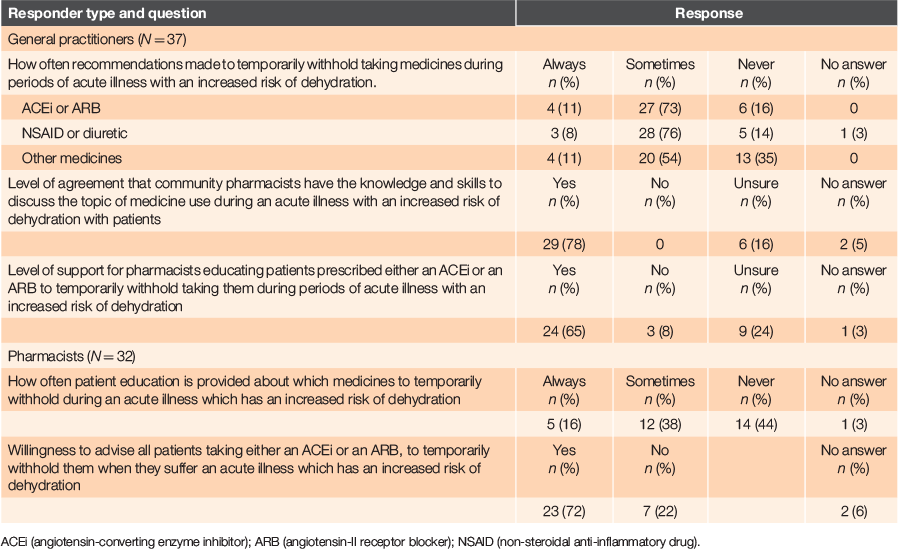
|
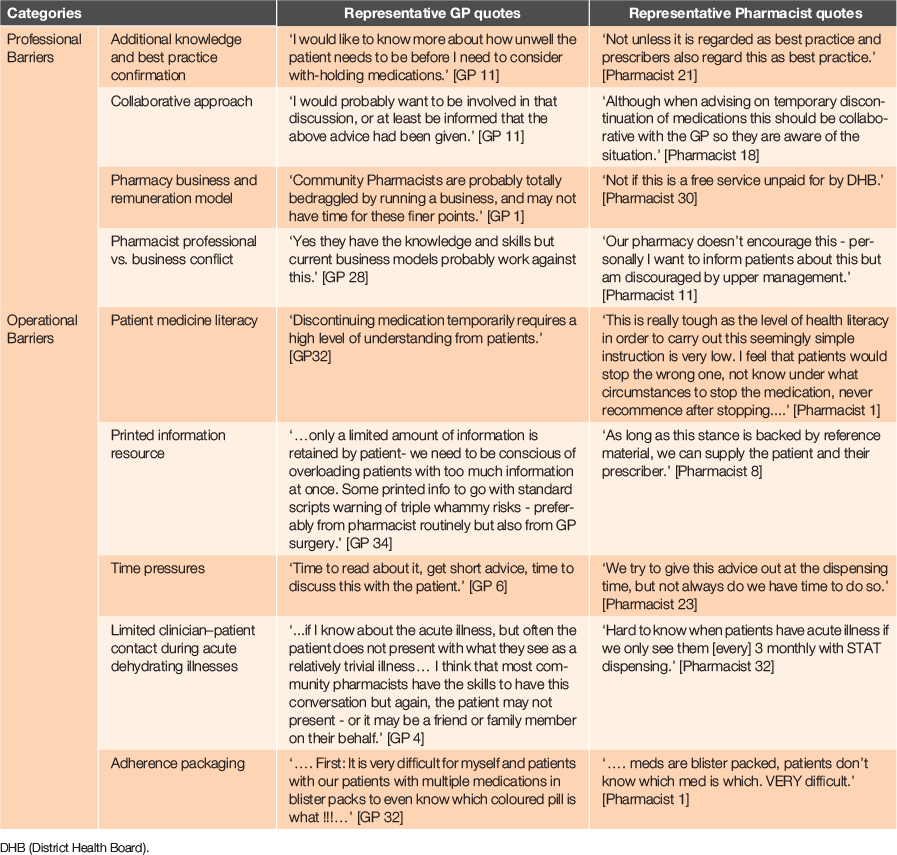
|
Community pharmacists’ current workplace practices when NSAID sales are being made are reported in Table 4. Most responding pharmacists had the perception that non-pharmacist staff were unlikely to ask customers purchasing a NSAID about concurrent medicines, acknowledging that if purchasers indicated taking other medicines, referral to a pharmacist would occur. Pharmacist respondents’ general approach to the sale of NSAIDs was to provide advice, counselling on NSAID-associated risks and recommending an alternative if appropriate.
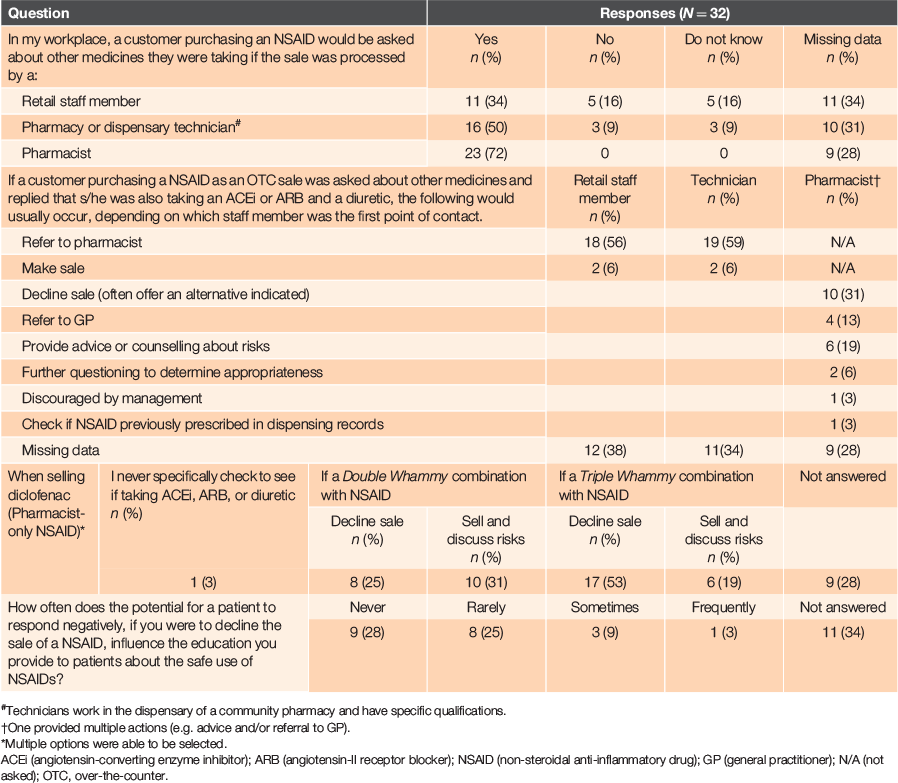
|
Pharmacists educating patients to temporarily withhold ‘at-risk’ medicines during acute dehydrating illnesses
Twenty-nine GP respondents considered that community pharmacists were capable of educating patients; 24 supported pharmacists advising patients prescribed an ACEi or ARB to temporarily withhold it during acute illnesses. GP perceptions around practicalities of pharmacists providing this education included: not all had the skills; the community pharmacy business model limitation; and pharmacists’ lack of time.
Twenty-three pharmacists would be prepared to provide this patient education (Table 2). Barriers indicated by pharmacists include: challenges of speaking directly with prescribers in a timely manner; lack of current GP–pharmacist collaboration on this topic; concerns about patient health literacy; and lack of time and remuneration (Table 3).
‘At-risk’ medicine and AKI risk management: Double and Triple Whammy
Current practices regarding patient advice provided for self-medicated NSAID when co-prescribed with ACEi, ARB and diuretic medicines are shown in Table 5. Similar responses were found for GPs and pharmacists regarding providing no patient advice (n = 3 and 2, respectively); advising not to use NSAIDs at all (n = 7 and 5, respectively); and modifying advice depending on a patient’s age (n = 17 and 10, respectively). Thirteen pharmacist respondents indicated patients may collect dispensed medicines without speaking to a pharmacist; in these cases, no advice would be provided about NSAID self-medication that would cause a Triple Whammy combination.
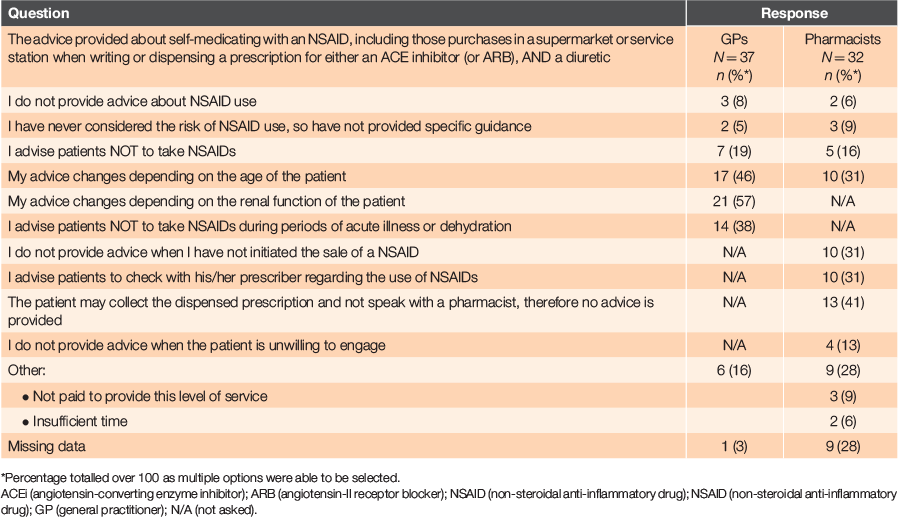
|
Current pharmacist actions taken and GP views on pharmacist actions when a Double or Triple Whammy combination occurs due to a NSAID being prescribed when ACEi, ARB and diuretic medicines are concurrently prescribed are shown in Table 6. No GP respondents expected pharmacists to dispense a NSAID prescription, resulting in either a Double or Triple Whammy combination, and not provide patient advice. However, one GP was unsure whether patients would accept the pharmacist’s advice. Approximately half of the GP respondents expected pharmacists to provide patient education about temporarily withholding NSAIDs, ACEis, or ARBs during acute illnesses; however, less than one-quarter of pharmacists indicated that they provided this education with prescriptions.
Twenty GP respondents expected pharmacists to contact them before dispensing a prescription that resulted in a Triple Whammy combination. One GP noted the increased importance if the NSAID was not prescribed by the GP, whereas another considered communication was only necessary if the pharmacist had a specific individual concern. Eleven pharmacist respondents would contact the prescriber prior to dispensing a Triple Whammy combination (Table 6). Barriers to pharmacists contacting prescribers if concerned about a prescribed Triple Whammy combination are shown in Table 7. Barriers reported reflected uncertainties around GP expectations and their acceptance of pharmacist communication; patient considerations; and operational barriers including time, inability to discuss prescriptions with prescribers in a timely manner, and insecurities about pharmacists’ professional roles.
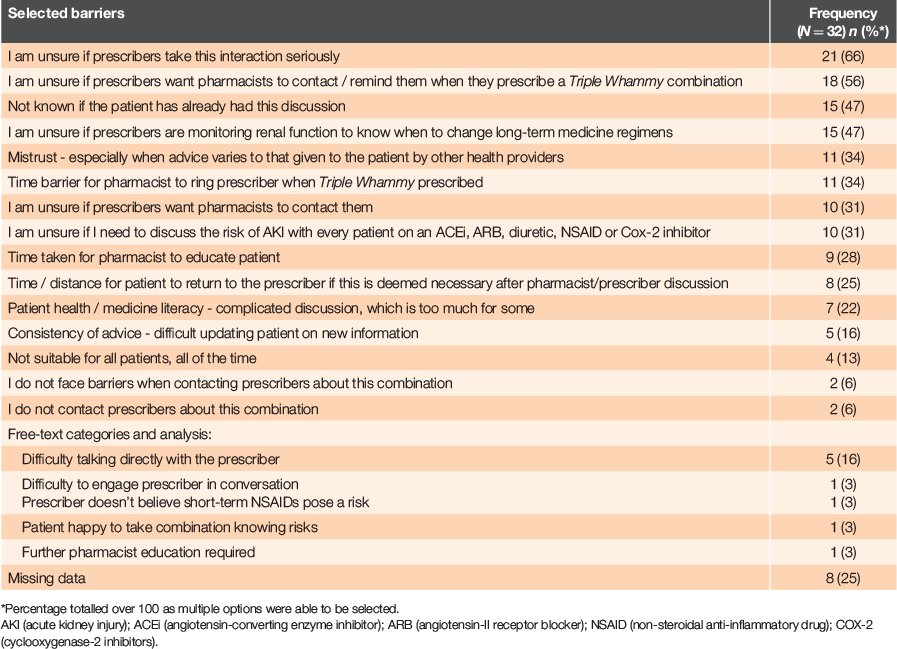
|
Discussion
Although our study respondents consider they have the skills and knowledge to educate people about temporarily withholding ‘at-risk’ medicines during acute dehydrating illnesses, it is not a routine practice for either professional group. There is general support for community pharmacists providing patient education, but both groups identified challenges to operationalisation. Education about safe NSAID self-medication, particularly for patients at risk of AKI when concurrent medicines lead to either a Double or Triple Whammy combination, is varied, along with GP misperceptions about the extent of patient education provided by pharmacists during the dispensing process.
We found that some GPs never provide pre-emptive temporary ‘at-risk’ medicine discontinuation education and most provide it ‘sometimes’. This may reflect New Zealand’s focus to stop ‘at-risk’ medicines when AKI has been established and raise awareness of risks associated with the Triple Whammy combination, together with the weak evidence reported for reducing net harm, limited evidence within primary care, and potential risks of this approach.13,14,21,22 How New Zealand clinicians implement the guidance to stop ‘at-risk’ medicines if AKI develops is a potential area for future research.
The barriers we found to providing pre-emptive temporary ‘at-risk’ medicine discontinuation education identified in our study are consistent with international research.23,24 The need for an agreed patient message and professional collective engagement between general practice and community pharmacy noted in our findings are reflected in international studies, which also recommend collaboration with secondary care and training of other providers such as carers and nursing staff.24 A parallel barrier is resourcing; incorporating this patient education into existing services and incentive structures suggested in international studies may need to be considered in New Zealand to support sustainability.23,24
Our findings of GPs’ support for pharmacists’ advisory roles is reflected in previous research, which found that GPs are generally supportive of the pharmacist’s role in new medicine review services.25–27 Although more accepting of pharmacists’ dispensing roles, acceptance has also grown for their medicine management services.25–27 In New Zealand, GPs have been reported to value pharmacists highlighting potential interactions and safety issues and support pharmacists having a greater role in providing medicine education to patients; pharmacists also report a keen awareness of GP sensitivities.28
A limitation of our study is that regular promotion of the survey over a long period of time may have drawn attention to the topic and influenced practice. Data were collected for this study in 2015 and 2016; practices may have changed between data collection and publication. Our study did not survey practice nurses who play a significant role in patient care and education in general practice, so their contribution to current practice is missing. We asked pharmacists about their staff’s actions; responses reflect pharmacists’ perceptions rather than actual staff actions. There was a low response rate from both groups and not all respondents answered all questions, resulting in the potential for non-responder and non-response bias limiting generalisability.
Our study highlights the expectations that GPs may have about current pre-emptive temporary ‘at-risk’ medicine discontinuation education provided by community pharmacists as part of the dispensing service, which is unlikely to occur routinely. Our study also reveals an interprofessional misunderstanding where GPs welcome pharmacists highlighting patients taking a Triple Whammy combination to them prior to dispensing the prescription, whereas community pharmacists believe this level of intervention could be unwelcome.
Some NSAIDs are classified as General Sale medicines, enabling public purchase without health professional education. Evidence suggests that the public have little knowledge about safe use of NSAIDs when purchased over-the-counter.29 Professional advice is a key point of difference for pharmacy. Overseas, campaigns promoting pharmacists as educators about the safe use of NSAIDs have increased pharmacist and public knowledge.30,31 Our study suggests that not all pharmacy businesses ensure customers receive key medicine information from well-trained staff; such campaigns may be of value in New Zealand.
This study suggests there is GP support for community pharmacists to provide patient education about pre-emptive temporary ‘at-risk’ medicine discontinuation during acute dehydrating illnesses, but barriers reported by both GPs and pharmacists will need consideration. New community pharmacy services are recommended to be developed and piloted in collaboration with primary and secondary care.24,25 Could the Integrated Health Care Framework, developed by The Pharmaceutical Society of New Zealand and the New Zealand Medical Association, be used to develop a collaborative approach for the provision of this patient education?32 The Royal Pharmaceutical Society of Great Britain has endorsed pharmacists providing pre-emptive temporary ‘at-risk’ medicine discontinuation patient education as an AKI harm-reduction strategy, supported by continuing education.6,30 Neither the New Zealand Pharmaceutical Society nor the Pharmacy Council of New Zealand have position statements on pharmacists’ roles in AKI management.
There is a role for both medical and pharmacist professional groups to strengthen prescriber–pharmacist relationships at both governance and operational levels. Although the Pharmacy Council and Nursing Council have the joint statement ‘Roles and Responsibilities of Pharmacists and Nurses’, there is no Pharmacy Council joint statement with the Medical Council.33 There has been much investment in patient portal and health pathway technology; is there now value in focusing on clinical portals for sharing information between general practice and community pharmacy, as well as secondary care?34,35 If health pathways and clinical portals are enablers for providing this patient education, these may be valuable to implement in Hawke’s Bay.
Concerns were raised about message complexity and patient health literacy. Therefore, a patient information resource to facilitate consistent messaging by multiple health providers is recommended.23,24 In New Zealand, Health Navigator and Kidney Health NZ provide AKI information, but this is not contextualised for New Zealand.36,37 There may be value in culturally appropriate resources being developed for the New Zealand population.
Conclusion
Study respondents were confident in their capability to provide pre-emptive temporary ‘at-risk’ medicine discontinuation education to reduce the risk of community-acquired AKI. GP respondents had confidence in pharmacists providing this education and pharmacist respondents were willing to provide it if additional training, prescriber support, and specific remuneration were provided.
Both GPs and community pharmacists have different expectations regarding the level of patient education provided by pharmacists as part of the dispensing function and the pharmacist interventions occurring when a Triple Whammy combination is prescribed. Collaborative planning between Hawke’s Bay health-care clinicians would be beneficial to clarify professional roles and develop consistent patient education regarding the ‘at-risk’ medicines to temporarily withhold during acute dehydrating illnesses, thus ensuring provision in a coordinated manner.
Ethics
The Health and Disability Ethics Committee’s scope of review determined that national ethical approval was not required for this research; registration with the Research Office at Hawke’s Bay District Health Board occurred.
Competing Interests
Dianne Vicary currently works for Hawke’s Bay District Health Board as a Portfolio Manager. On behalf of other authors, the corresponding author states that there are no competing interests.
Funding
This research did not receive any specific funding.
Acknowledgements
Authors acknowledge governance support from Hawke’s Bay District Health Board and Health Hawke’s Bay PHO. Thanks to Mr Billy Allan, Dr Anne Denton, Ms Christina Crawford, Mr Alex Chan, and Dr Mark Peterson for their input.
References
[1] Kellum JA, Lameire N, Aspelin P, et al. Kidney disease: Improving Global Outcomes (KDIGO) Acute Kidney Injury Work Group. KDIGO Clinical Practice Guideline for Acute Kidney Injury. Kidney Int Suppl. 2012; 2 1–138.[2] Wang X, Bonventre JV, Parrish AR. The aging kidney: increased susceptibility to nephrotoxicity. Int J Mol Sci. 2014; 15 15358–76.
| The aging kidney: increased susceptibility to nephrotoxicity.Crossref | GoogleScholarGoogle Scholar | 25257519PubMed |
[3] National Institute for Health and Care Excellence. Acute kidney injury: prevention, detection and management. NICE guideline [NG148]. London: NHS England; 2019. [cited 2020 April 18]. Available from: https://www.nice.org.uk/guidance/ng148
[4] Selby NM, Crowley L, Fluck RJ,, et al. Use of electronic results reporting to diagnose and monitor AKI in hospitalized patients. Clin J Am Soc Nephrol. 2012; 7 533–40.
| Use of electronic results reporting to diagnose and monitor AKI in hospitalized patients.Crossref | GoogleScholarGoogle Scholar | 22362062PubMed |
[5] Dasta JF, Kane-Gill S. Review of the literature on the costs associated with Acute Kidney Injury. J Pharm Pract. 2019; 32 292–302.
| Review of the literature on the costs associated with Acute Kidney Injury.Crossref | GoogleScholarGoogle Scholar | 31291842PubMed |
[6] Royal Pharmaceutical Society & Centre for Pharmacy Postgraduate Education. Medicines optimisation briefing. London: Royal Pharmaceutical Society & Centre for Pharmacy Postgraduate Education; 2015. [cited 2020 June 22]. Available from: https://www.cppe.ac.uk/wizard/files/news%20attachments/aki_mo_briefing_final.pdf
[7] Diabetes Canada Clinical Practice Guidelines Expert Committee Diabetes Canada 2018 Clinical Practice Guidelines for the Prevention and Management of Diabetes in Canada. Can J Diabetes. 2018; 42 S1–S325.
| 29650079PubMed |
[8] NHS Scotland. Medicines Sick Day Rules Card. Edinburgh: The Improvement Hub: Healthcare Improvement Scotland, 2020. [cited 2020 June 27]. Available from: https://ihub.scot/improvement-programmes/scottish-patient-safety-programme-spsp/spsp-medicines-collaborative/high-risk-situations-involving-medicines/medicines-sick-day-rules-card/
[9] Huerta C, Castellsagué J, Varas-Lorenzo C, García Rodríguez LA. Non-steroidal anti-inflammatory drugs and risk of AFR in the general population. Am J Kidney Dis. 2005; 45 531–9.
| Non-steroidal anti-inflammatory drugs and risk of AFR in the general population.Crossref | GoogleScholarGoogle Scholar | 15754275PubMed |
[10] Lapi F, Azoulay L, Yin H, et al. Concurrent use of diuretics, angiotensin converting enzyme inhibitors, and angiotensin receptor blockers with non-steroidal anti-inflammatory drugs and risk of acute kidney injury: nested case-control study. BMJ. 2013; 346 e8525
| Concurrent use of diuretics, angiotensin converting enzyme inhibitors, and angiotensin receptor blockers with non-steroidal anti-inflammatory drugs and risk of acute kidney injury: nested case-control study.Crossref | GoogleScholarGoogle Scholar | 23423367PubMed |
[11] Camin RMG, Cols M, Chevarria JL, et al. Acute kidney injury secondary to a combination of rennin-angiotensin system inhibitors, diuretics and NSAIDS. “The Triple Whammy”. Nefrologia. 2015; 35 197–206.
| Acute kidney injury secondary to a combination of rennin-angiotensin system inhibitors, diuretics and NSAIDS. “The Triple Whammy”.Crossref | GoogleScholarGoogle Scholar |
[12] Health Quality & Safety Commission. Over 22,000 NZers at risk of kidney harm because of medicine ‘triple whammy’. Wellington: Health Quality & Safety Commission New Zealand; 2017. [cited 2020 June 6]. Available from: https://www.hqsc.govt.nz/news-and-events/news/3101/
[13] Medsafe Pharmacovigilance Team NSAIDS and acute kidney injury. Prescriber Update. 2013; 34 14–5.
[14] Medsafe Pharmacovigilance Team Acute kidney injury - dangerous to continue some medicines. Prescriber Update. 2014; 35 9–10.
[15] Best Practice Advocacy Centre New Zealand. Avoiding the triple whammy in primary care: ace inhibitors / ARB + diuretic + NSAID. Dunedin: Best Practice Advocacy Centre New Zealand; 2018. [cited 2020 March 7]. Available from: https://bpac.org.nz/2018/docs/triple-whammy.pdf
[16] Pharmacy Council of New Zealand. Code of Ethics. Wellington: Pharmacy Council of New Zealand; 2018. [cited 2018 September 14]. Available from: https://www.pharmacycouncil.org.nz/Portals/12/Documents/standardsguidelines/Code%20of%20Ethics%202018%20FINAL.pdf?ver=2018-03-04-215933-993
[17] Ministry of Health. Pharmacy Action Plan 2016 to 2020. Wellington: Ministry of Health; 2016. [cited 2020 June 22]. Available from: https://www.health.govt.nz/publication/pharmacy-action-plan-2016-2020
[18] Pai AB. Keeping kidneys safe: the pharmacist’s role in NSAID avoidance in high-risk patients. J Am Pharm Assoc. 2015; 55 e15–e25.
| Keeping kidneys safe: the pharmacist’s role in NSAID avoidance in high-risk patients.Crossref | GoogleScholarGoogle Scholar |
[19] Graneheim UH, Lundman B. Qualitative content analysis in nursing research: concepts, procedures and measures to achieve trustworthiness. Nurse Educ Today. 2004; 24 105–12.
| Qualitative content analysis in nursing research: concepts, procedures and measures to achieve trustworthiness.Crossref | GoogleScholarGoogle Scholar | 14769454PubMed |
[20] Bengtsson M. How to plan and perform a qualitative study using content analysis. NursingPlus Open. 2016; 2 8–14.
| How to plan and perform a qualitative study using content analysis.Crossref | GoogleScholarGoogle Scholar |
[21] Think Kidneys Board. “Sick day” guidance in patients at risk of Acute Kidney Injury: position statement. Bristol: UK Renal Registry; 2020. [cited 2020 February 24]. Available from: https://www.thinkkidneys.nhs.uk/aki/wp-content/uploads/sites/2/2020/01/2020-AKI-Sick-Day-Guidance-Think-Kidneys.pdf
[22] Whiting P, Morden A, Tomlinson LA, et al. What are the risks and benefits of temporarily discontinuing medications to prevent acute kidney injury? A systematic review and meta-analysis. BMJ Open. 2017; 7 e012674
| What are the risks and benefits of temporarily discontinuing medications to prevent acute kidney injury? A systematic review and meta-analysis.Crossref | GoogleScholarGoogle Scholar | 28389482PubMed |
[23] Morris RL, Ashcroft D, Phipps D, et al. Preventing acute kidney injury: a qualitative study exploring ‘sick day rules’ implementation in primary care. BMC Fam Pract. 2016; 17 91
| Preventing acute kidney injury: a qualitative study exploring ‘sick day rules’ implementation in primary care.Crossref | GoogleScholarGoogle Scholar | 27449672PubMed |
[24] Martindale AM, Elvey R, Howard SJ, et al. Understanding the implementation of ‘sick day guidance’ to prevent acute kidney injury across a primary care setting in England: a qualitative evaluation. BMJ Open. 2017; 7 e017241
| Understanding the implementation of ‘sick day guidance’ to prevent acute kidney injury across a primary care setting in England: a qualitative evaluation.Crossref | GoogleScholarGoogle Scholar | 29122792PubMed |
[25] Hatah E, Braund R, Duffull S, Tordoff J. General practitioners’ perceptions of pharmacists’ new services in New Zealand. Int J Clin Pharm. 2012; 34 364–73.
| General practitioners’ perceptions of pharmacists’ new services in New Zealand.Crossref | GoogleScholarGoogle Scholar | 22359183PubMed |
[26] Pharmacy Council of New Zealand. Medicines management: definition, levels, competence framework. Wellington: Pharmacy Council of New Zealand; 2006. [cited 2020 June 22]. Available from: https://www.pharmacycouncil.org.nz/dnn_uploads/Documents/standardsguidelines/PCNZ%20MedMgmtCompFramework%20Oct%2009.pdf?ver=2017-02-20-105111-513
[27] Bryant L, Maney J, Martini N. Changing perspectives of the role of community pharmacists: 1998 – 2012. J Prim Health Care. 2017; 9 34–46.
| Changing perspectives of the role of community pharmacists: 1998 – 2012.Crossref | GoogleScholarGoogle Scholar | 29530186PubMed |
[28] Bidwell S, Thompson L. GPs, community pharmacists and shifting professional boundaries. N Z Med J. 2015; 128 19–26.
| 26117387PubMed |
[29] Mullan J, Weston K, Bonney A, et al. Consumer knowledge about over-the-counter NSAIDs: they don’t know what they don’t know. Aust N Z J Public Health. 2017; 41 210–4.
| Consumer knowledge about over-the-counter NSAIDs: they don’t know what they don’t know.Crossref | GoogleScholarGoogle Scholar | 27774735PubMed |
[30] Centre for Pharmacy Postgraduate Education. Acute kidney injury. Manchester, UK: The University of Manchester; 2018. [cited 2018 September 14]. Available from: https://www.cppe.ac.uk/programmes/l/kidneydl-p-01/
[31] National Institute of Diabetes and Digestive and Kidney Diseases. Counselling patients on NSAID use to prevent kidney injury - Continuing Education Program. London: National Institutes of Health; 2014. [cited 2020 June 22]. Available from: https://www.niddk.nih.gov/health-information/professionals/education-cme/counseling-patients-nsaid-use?dkrd=hisce0082
[32] Pharmaceutical Society of New Zealand and New Zealand Medical Association. An integrated framework for pharmacists and doctors. Wellington: Pharmaceutical Society of New Zealand and New Zealand Medical Association; 2017. [cited 2020 June]. Available from: https://www.psnz.org.nz/Folder?Action=View%20File&Folder_id=96&File=IntegratedHealthCareFramework_Final.pdf
[33] Pharmacy Council of New Zealand and Nursing Council of New Zealand. Pharmacists and nurses: roles and responsibilities. Wellington: Pharmacy Council of New Zealand and Nursing Council of New Zealand. [cited 2020 June 22]. Available from: https://www.pharmacycouncil.org.nz/dnn_uploads/Documents/standardsguidelines/Pharmacy%20Council%20_%20Nursing%20Council%20-%20Joint%20Statement%20-%20Oct%202018.pdf?ver=2018-10-09-195032-647×tamp=1539114742359
[34] Ministry of Health. Patient portals. Wellington: Ministry of Health; 2016. [cited 2020 July 20]. Available from: https://www.health.govt.nz/our-work/digital-health/other-digital-health-initiatives/patient-portals
[35] HealthPathways Community. What is HealthPathways? Christchurch: HealthPathways Community, Canterbury District Health Board, and Streamliners NZ; 2020. [cited 2020 July 11]. Available from: https://www.healthpathwayscommunity.org/About
[36] Health Navigator Editorial Team. Acute kidney injury. Wellington: Health Navigator Charitable Trust; 2020. [cited 2020 June 20]. Available from: https://www.healthnavigator.org.nz/health-a-z/k/kidney-acute-kidney-injury/
[37] Kidney Health New Zealand. Information on kidney disease. Christchurch: Publisher; 2015. [cited 2020 June 20]. Available from: https://www.kidney.health.nz/Patient-Information/Information-on-Kidney-Disease/


